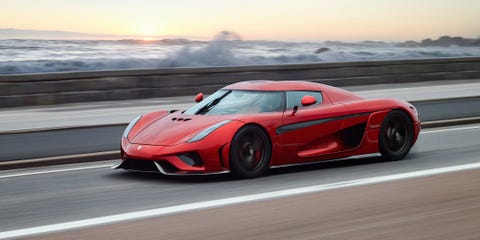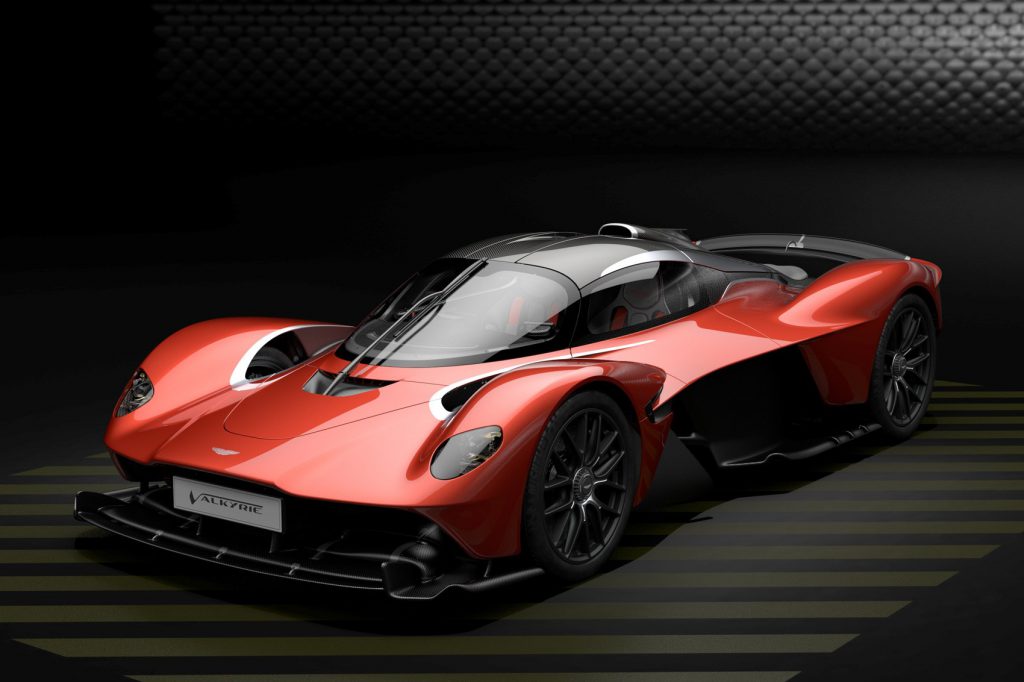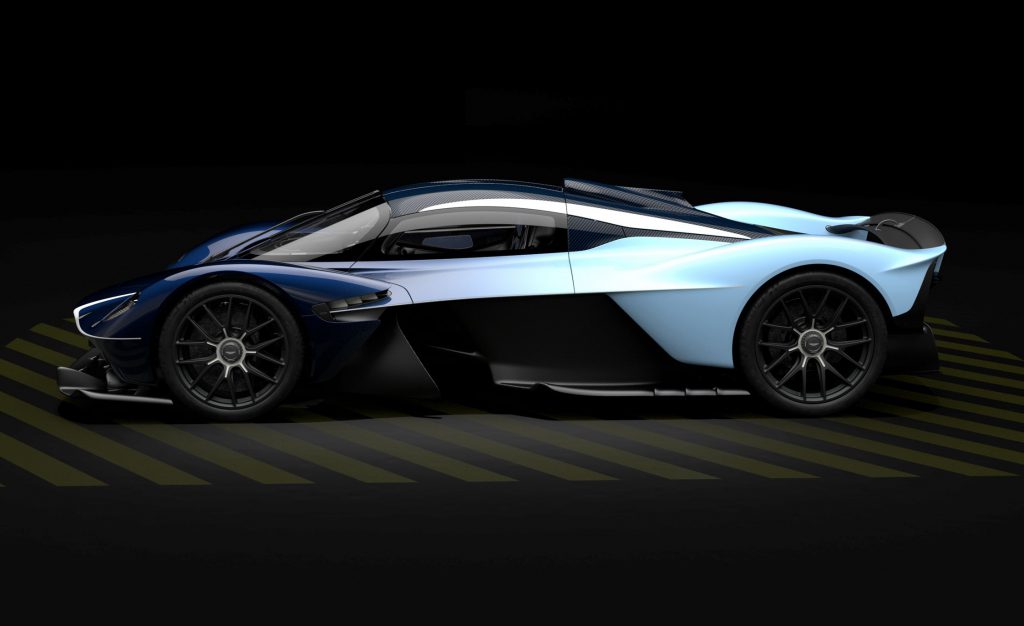2019 Rolls-Royce Cullinan: 6 Cool Facts

Trend Alert
The Cullinan is a big deal, and not because it weighs nearly 6,000 pounds. Although Rolls-Royce‘s first SUV starts rolling into driveways this holiday season, you don’t have to wait for one to appear under a freakishly large Christmas tree to learn more about it. As we discovered when we drove the 2019 Cullinan, the Rolls-Royce is more of a stately super-luxury cruiser than a quick and posh back-road carver. Great. But how much do you really know about the 563-hp, 12-cylinder Rolls-Royce Cullinan? Keep reading for six cool facts about the new SUV.
Rolls-Royce says it’s starting to hear interest from a few customers who want an alternative to high-quality leather. Such an option may become available on the Cullinan down the line, but not until the right, no-compromises leather alternative is found, one representative told us. We’ve begun to see premium fabrics on lower-priced luxury cars, from a base-model Volvo V60 wagon whose interior wowed MotorTrend editors, to the non-leather seating options on the Range Rover Velar and electric Jaguar I-Pace, which combines a wool blend with a suede-like material.

Options
For the type of experience the Rolls-Royce Cullinan offers, $330,350 (including destination and gas guzzler fees) is an appropriate price. But no one drives home in a base-model Rolls-Royce. Sales to early adopters of the new model are in the $380,000-to-$390,000 range, Rolls-Royce says.

Lounging
For a traditional Rolls-Royce experience, order the Cullinan with the so-called Individual seating—a four-passenger layout with two separate rear seats. Between the reclining seats sits a drinks cabinet with a refrigerator and champagne flutes, as well as Rolls-Royce whisky glasses and decanter. If this is your family road trip car, maybe go for the five-seat Lounge option. Although you can order the Cullinan any way you wish, Rolls-Royce expects about 80 percent of American customers to pick the five-seat Lounge option, but just 50 percent for Chinese buyers.

Wheels
Twenty-two-inch wheels make the most of the Cullinan’s imposing presence (yes, like that Cadillac). Those wheels are standard in the U.S.—Rolls-Royce will make the 21s a no-cost option. Winter tires are available on the 21-inch wheels, and all Cullinan tires are specially designed to reduce road noise. And maybe it works, because the Cullinan provides a smooth and quiet ride, just as you’d expect from a Rolls-Royce.
By: Zach Gayle, December 29, 2018
For more cars, visit: https://www.motortrend.com/news/2019-rolls-royce-cullinan-6-cool-facts/
Source: https://www.motortrend.com/
The 205-MPH 2020 Alpina B7 Is the Fastest Sedan In the World

The 200-mph club is an exclusive one. Less than 20 cars on sale today are members, and of those, there are only five sedans. Today though, a sixth joins. The Alpina B7 has been updated for 2020, and it boasts a claimed 205-mph top speed, making it the fastest four-door of the bunch. By our reckoning, it’s the fastest sedan there’s ever been.
Alpina says the current-generation B7 was able to do 205 mph before the 2020 model-year update, but in the US at least, it was limited to 192 mph. A BMW USA spokesperson told us the 2020 B7 will be capable of an honest 205 mph here. Humorously, the B7 can be fit with all-season tires, and so equipped, the top speed is limited to 130 mph.
The Alpina B7 is, of course, based on the current-generation BMW 7-Series, which was updated for 2020, mainly with an absolutely enormous pair of kidney grilles. As before, the B7 is powered by a 4.4-liter twin-turbo V8 with 600 hp and 590 lb-ft of torque, though the engine has been upgraded with larger turbo impellers and new software. Alpina also upgraded the 7er’s eight-speed automatic transmission and all-wheel drive system for the 2020 B7.
The B7 also gets air springs that lower the car 0.6 inches when placed into Sport+ mode, which surely helps reduce drag on the way to 205. All of that helps shave a tenth off the B7’s 0-60 mph time, bringing it down to just 3.5 seconds. BMW’s own V12-powered M760i only manages 3.6 seconds, though it’ll probably be updated in the not-too-distant future.
As you’d expect, the B7 gets all the other upgrades that come to the 7-Series for 2020 including a new digital gauge cluster, and the latest version of BMW’s iDrive infotainment system.
And while it could just be these photos, we think the B7 is the best looking of the new 7er bunch. Alpina’s signature blue paint and multi-spoke wheels generally tend to do good things for BMWs, and that’s true here.
Such speed and luxury don’t come cheap. The 2020 B7 will cost $141,700 when it goes on sale in the third quarter of this year, and that doesn’t include a $1000 destination fee.
This is the New Bugatti Chiron Sport ‘110 ans Bugatti’
In 1909, Bugatti founder Ettore Bugatti unveiled his first ever model, the Type 10. It was “light, small and nimble with an adequate power output”. In 2019, Bugatti has unveiled this new, limited edition Chiron Sport ‘110 ans Bugatti’.
It celebrates 110 years since the first ever Bugatti obviously, but takes few cues from that first car. The Bugatti Chiron Sport ‘110 ans Bugatti’ is not light. It is also not very small. Nimble? Actually yeah. Adequate power output? We’d proffer, 1,479bhp is just about adequate.
What you get in place of lightness and smallness is a celebration of Bugatti’s French roots. The special Chiron gets a body and front constructed from carbon fibre, finished in a matt ‘Steel Blue’ (or should that be – narrows eyes, pouts lips – Blue Steel?) paintjob, along with exposed carbon fibre in steel blue carbon. There’s a matt black exhaust system too.
The French tricolour is embellished across the exterior mirrors, across the fuel filler cap, and layered across the underside of that giant rear wing. Even the brake calipers are blue.
This theme is reflected inside too: the headrests, back of the front seats, and the top point of the steering wheel all feature the tricolour. The entire interior is decorated in blue leather, while the trim is Alcantara.
There’s no more power on offer in this exclusive new Chiron – limited to just 20 cars worldwide – but you’d be hard pushed to want more. It’ll still do 0-62mph in less than 2.4secs, and top out at over 261mph. It’s based on the ‘Sport’, which comes with stiffer shocks, modified steering, a new rear diff setup and torque vectoring.
It’s also lighter, and gets a carbon fibre wiper too, and all those changes over the regular Chiron make the Sport version five seconds faster around Nardo. So fairly rapid, then.
Koenigsegg’s Next Supercar Will Have a Camless Engine

Pictured above: the hybrid, gearbox-less Koenigsegg Regera.
Company founder and boss Christian von Koenigsegg told Top Gear that it’s working on a new hybrid supercar with a pricetag of around €1 million ($1.15 million) to increase its annual sales to a few hundred cars. Oh, and it’ll have an engine without camshafts.
Yes, Koenigsegg is apparently right on the cusp of bringing its innovative Freevalve technology to the market. Instead of using traditional camshafts to open and close valves, a Freevalve engine uses pneumatic actuators. This allows far more control over what the engine does. Theoretically, a Freevalve engine can run on diesel, gas, or alcohol with no mechanical changes—though not at the same time—and can even switch from a two-stroke to a four-stroke cycle. Speaking to Jalopnik in 2014, Koenigsegg said using camshafts was like using a broom to play a piano, while pneumatic actuators are more like using fingers.
“Our ambition is that this car will be completely CO2 neutral,” Koenigsegg told Top Gear. The company is aiming to do so by combining a Freevalve engine with hybrid technology sourced from NEVS. “Given the Freevalve technology, we can actually cold-start the car on pure alcohol, down to -30 degrees Celsius, so there’s no need for any fossil fuel mix then. The idea is to prove to the world that even a combustion engine can be completely CO2 neutral.”
Koenigsegg seems to imply this hybrid will come in addition to the soon-to-arrive successor to the Agera RS. Last year, Koenigsegg told us his company will always aim to offer at least two models. Apparently that means a low-volume supercar and a really low-volume hypercar.
We’ve reached out to Koenigsegg for additional info, and we should know a lot more about the company’s plans in the coming weeks. We’re incredibly excited, and you should be too.
By: Chris Perkins, January 31, 2019
For more cars, visit: https://www.roadandtrack.com/new-cars/future-cars/a26098563/koenigsegg-hybrid-supercar-camless-freevalve-engine/
Source: https://www.roadandtrack.com/
Your New Office On Wheels!
This Crazy Widebody Mercedes-AMG G63 Packs 720-bhp

The Mercedes-AMG G63 is a class of its own. A lunchbox by form, it packs unbelievable numbers that you’ll usually find in sleek supercars. Its biturbocharged 4.0-litre V8 mill can churn out 577 bhp and 627 pound-feet of torque, enough to launch you to the dark side of the moon and back. Okay, maybe not.
With these performance figures, many have tried to challenge the German SUV on the drag strip. While its anti-aerodynamic shape would mean great disadvantage in a straight-line race, the AMG G63 was able to rise to the top, even beating a Range Rover SVR and an Audi SQ7.
Now, what can make the AMG G63 better? Well, tune it, add some body kits, and drive it like hell – like this one right here: the Mercedes-AMG G63 “Onyx Edition.”
This mental build is of course not an official Mercedes variant, but it still is an interesting aftermarket creation made by Onyx Concept – a London-based tuner.
Armed with complete body kits such as aero front bumpers and side sill enhancements, as well as carbon fibre side vents, rear diffuser, ducktail spoiler, and rear wing. It also has bespoke exhaust; two of them are found at the sides. The bonnet is vented as well plus the wheels have been upgraded to 22-inch diamond finished Amethyst wheels. Although, we must admit, the brakes look a bit small for those enormous wheels. Nevertheless, the huge wheels match the widebody kit of the G-Wagen, which kind of surprised us since we never thought that this SUV could rock a wider stance.
Of course, the most important part of this tuned G63 is its increased power rating, which went up to 720 bhp. Watch this crazy build in action on the video below. Oh, by the way, the build costs £200,000.
For full VIDEO, click here: https://www.youtube.com/watch?v=QpOzl1Yb5w8
By: Jacob Oliva, January 28, 2019
For more cars, visit: https://uk.motor1.com/news/302883/mercedes-amg-g63-widebody-720bhp/
Source: https://uk.motor1.com/
2020 Lamborghini Huracan EVO First Drive

Evo is essentially the midcycle reset for the entire Huracan model line. The three letters means evoluzione and reflect the evolution of the new base model. Gone is the Huracan LP610-4 coupe (and that naming convention); every future Huracan variant will be based on the Evo. And what a place to begin, as Evo upgrades the base coupe with the Performante’s 630-horsepower V-10 and next-generation electromechanicals culled from across Lamborghini, including torque vectoring, rear-wheel steering, and something called inertial platform. Everything else is about the same. The Evo’s chassis components, stiffness, and even overall weight are the same as the coupe, Lamborghini chief technical officer Maurizio Reggiani claims. From a hardware perspective, the Evo’s V-10 has 99 percent parts commonality with the Performante’s, but Reggiani says the software has many key differences; notably, the Evo redlines 500 rpm lower at “only” 8,000 rpm.
The design is evolutionary, as well; 20-inch Y-spoked wheels wrapped in Pirelli P Zero rubber are the most obvious tip-off from afar. Only the nose and tail of the stealth-fighter-influenced Huracan have been Evo-tweaked with a front chin spoiler and a small integrated wing in the rear decklid. Repositioning the exhaust pipes to the middle of the rear fascia, with their twin cannonlike tips protruding around the license plate, doesn’t just look a lot more racy (and indeed were inspired by MotoGP bikes and Lamborghini’s GT3 race car). It also provides real estate for a taller, more substantial rear diffuser. There is no large rear wing or ALA active aerodynamics system, but Reggiani claims a sixfold improvement in aerodynamic efficiency and seven times more downforce over the Huracan coupe.
Evo is the same weight as its predecessor, which means it’s about 88 pounds heavier than the Performante. But here’s where it gets interesting: Reggiani claims the Evo is a whopping 3.0 seconds faster than the base Huracan coupe over Lamborghini’s 5-mile test course at the Nardo Ring, where it also just clips the Performante.

How? Lamborghini Dynamic Vehicle Integration (LDVI), a fully integrated vehicle dynamics control system with a single CPU that governs five main subsystems: torque vectoring all-wheel drive, all-wheel steering, traction control, adaptive magnetorheological dampers, and that inertial platform (called LPI—Lamborghini Piattaforma Inerziale). LPI 2.0 is an updated set of accelerometers and gyroscopic sensors placed near the vehicle’s center of gravity to monitor the real-time attitude of the car, including acceleration in the lateral, longitudinal, and vertical directions, as well as roll, pitch, and yaw. LPI and the other systems inform the LDVI controller (by relaying such inputs as steering wheel, brake, and throttle position, as well as engaged gear, drive mode, and torque split). Lamborghini claims external conditions can be determined via feedback from the active suspension and a grip estimation function of the all-wheel-drive system. Reggiani says LDVI processes all of this information in real time and uses “feed-forward logic” to make new, dedicated settings for all subsystems in 20 milliseconds. (In comparison, a human eye blink takes between 100 and 150 milliseconds.) “It doesn’t just react; the car predicts the best driving setup for the moment,” says Reggiani, who also confirmed that LDVI is a Lamborghini exclusive; platform-mate Audi R8 won’t get it.
To find out whether any of this was remotely discernible or true, we took a total of 12 hot laps in three lead-follow sessions (chasing a Lamborghini test driver) at the glorious Bahrain International Circuit, the Middle East’s premier F1 track, which debuted in 2004. Last fall, we named the Huracan Performante our Best Driver’s Car, so prior to this outing, I pinged my fellow editor-judges for thoughts on how the best could be made better. Brakes were a consistent theme.

“I’d prefer more feel from the brake pedal—it’s just hard and dead,” road test editor Chris Walton said. Guest judge and Automobile‘s own Jethro Bovingdon agreed: “They go very hard and dead under extreme use. The ABS was also triggering a lot of you touched any curb.” There were also some requests for increased nimbleness and a more neutral attitude (less under- and oversteer, through corners).
First, the bad news. No one on Team MotorTrend is going to like the brakes. Despite six-piston front and four-piston rear calipers grabbing cross-drilled and ventilated carbon-ceramic discs, the feel is surprisingly soft at first stab, without the linearity of the very best sports cars. Judging braking points at high speeds is tricky, often requiring an exploratory dab to find the engagement point, and then harder and harder effort to bring about predictable deceleration. A full damn-the-torpedoes stomp at the end of one of BIC’s long straights sends the Evo (and my jowls) diving forward, but as the car slows, the lightened rear end wags noticeably. Not scary, but not reassuring, either. When I mentioned that perhaps more wing (a la Performante) might help settle the rear, Reggiani nodded knowingly and said, “Yes, yes, but we need to leave something for later, right?”
By: Edward Loh, January 25, 2019
For more cars, visit: https://www.motortrend.com/cars/lamborghini/huracan/2020/2020-lamborghini-huracan-evo-first-drive-review/
Source: https://www.motortrend.com/
“To our couple of lucky members we can’t wait until yours arrive!” -Scott

The obsessive attention to detail that’s going into the upcoming Aston Martin Valkyrie is something we haven’t seen in a car since the McLaren F1. Much of that attention is focused on weight savings. So much so that the Valkyrie’s mastermind, Adrian Newey, apparently balked when he saw a prototype for its V12 engine with a lacquered carbon-fiber intake manifold. He demanded that the manifold come unlacquered as standard, which saves just 80 grams.
You probably wouldn’t sweat 80 grams, and nor would I, but that’s what makes Adrian Newey different than us. That’s why he’s designed 10 F1 constructor’s championship-winning cars and I’m sitting here blogging about him.
In the spirit of obsessive weight-savings, the Valkyrie has a lightweight paint option, which is detailed in a Top Gear video all about configuring the hypercar. Aston interior design manager Libby Meigh told Top Gear that three “ultra-light” paints would be offered on the Valkyrie and they save around 700 grams over regular paint. That’s just 1.54 pounds.

Now, I realize that this basically amounts to the difference between having fries with your burger instead of a salad, but, you have to admire how it fits with the spirit of the car. After all, if you compromise on the weight of the paint, you might as well compromise on everything. If I were speccing-out my Valkyrie, I’d have to go with the lightweight paint—it’s the sort of decision you’d hope Adrian Newey would admire.
Aston Martin hasn’t announced a final weight figure for the Valkrie yet, but we’ve heard it should be under 2300 lbs. That’s less weight than a new Miata, with around six times as much horsepower. It makes the otherwise-lithe, 3030-pound McLaren Senna seem porky by comparison.
That’s the sort of result you get when you sweat the small stuff. Including the paint.
By: Chris Perkins, January 23, 2019
For the full TopGear video, click here: https://www.youtube.com/watch?v=BAY8P-WcZAA
For more cars, visit: https://www.roadandtrack.com/new-cars/future-cars/a26007571/aston-martin-valkyrie-lightweight-paint/
Source: https://www.roadandtrack.com/
Mercedes-Benz AMG GT 4-door Review
We have the Porsche Panamera to thank for the existence of the AMG GT 4dr. Despite a plethora of fast, expensive machinery at the top of the Mercedes range (E63S, S63 saloon and coupe, CLS53, AMG GT S etc), Mercedes was losing customers who were unable to upgrade to the car they really wanted. Which was, apparently, a very fast, coupe-ish, four-door, sports-focussed, very expensive family car. Niche, eh? You could argue that was the role performed by the old CLS63, but that was deemed too cheap, too GT-ish to tackle the Panamera.
So now we have a four-door AMG GT. Although underneath it actually has much more in common with the E63 and new CLS. Yep, the name is disingenuous, given that this new car uses the MRA platform that underpins the C-Class, E-Class, CLS and various other Mercedes’, and therefore isn’t a four-door version of the GT at all. But it has been modified, gaining extra strengthening for the body.
Up steps the 4.0-litre twin turbo V8, available, like the E63, in S (631bhp) or non-S (577bhp) outputs. The fourteen grand price difference between the two (£121k plays £135k) is also accounted for by the S having dynamic engine mounts, an electric locking rear diff, and the ability to disconnect the front driveshafts and indulge yourself in Drift Mode. In Europe there are also GT 53 and 43 versions, which use the new 3.0-litre in-line six-cylinder in 423 or 357bhp forms. Neither of those is likely to make it to the UK.
In due course there will be a hybrid. Or maybe two. Mercedes mentions the fact that 40 per cent of Panameras are hybrids, e-power available in conjunction with both V6 and V8 motors. Stands to reason Merc might want a slice of the same action, so a 631bhp-plus-e-boost could be on the cards.
Like the Panamera, it’s long (over five metres), heavy (2,100kg and upwards), and luxurious. The driving environment has overtones of both AMG GT and S-Class, four seats are standard, a fifth optional and there’s a big boot, the space smuggled in under a swooping, almost endlessly elongated coupe silhouette. It’s a handsome beast, with greater street presence than its key rival. It features active aero: a 20-fin Air Panel grille enlivens the front end, at the rear there’s a multi-stage rear spoiler that flips up to increase stability under braking.
Prices might start at £121,350, but that’s just a stepping off point – let’s face it you’re going to be fitting 21in forged rims and matt magno paint, aren’t you?
By: Various Top Gear Journalists
For more cars, visit: https://www.topgear.com/car-reviews/mercedes-benz/amg-gt-4-door
Source: https://www.topgear.com/








